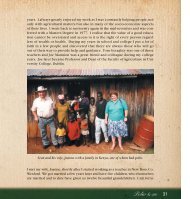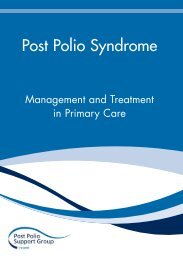Post Polio Syndrome - Management & Treatment in Primary
Post Polio Syndrome - Management & Treatment in Primary
Post Polio Syndrome - Management & Treatment in Primary
Create successful ePaper yourself
Turn your PDF publications into a flip-book with our unique Google optimized e-Paper software.
22 <strong>Post</strong> <strong>Polio</strong> <strong>Syndrome</strong><br />
movements that might occur secondary to muscle weakness, and note<br />
surgical procedures such as jo<strong>in</strong>t fusion or tendon transfers that may have<br />
occurred <strong>in</strong> the past and affect strength test<strong>in</strong>g.<br />
Musculoskeletal<br />
A standard musculoskeletal exam<strong>in</strong>ation should be performed with<br />
assessment of areas of pa<strong>in</strong> identified <strong>in</strong> the subjective assessment. Range<br />
of movement of jo<strong>in</strong>ts should be recorded objectively and a detailed<br />
postural exam<strong>in</strong>ation performed as deformity can change with time. A<br />
detailed biomechanical evaluation should be <strong>in</strong>corporated as complex<br />
biomechanical problems are frequent.<br />
Pa<strong>in</strong> is one of the most commonly described symptoms <strong>in</strong> prior polio<br />
patients with 38% to 86% report<strong>in</strong>g muscle pa<strong>in</strong> and 42% to 80% jo<strong>in</strong>t<br />
pa<strong>in</strong>. Risk factors for pa<strong>in</strong> are summarised <strong>in</strong> Box 3.<br />
box 3: risk FaCtors For Pa<strong>in</strong><br />
Female gender Weaker lower extremities<br />
Weaker at time of onset Younger at time of onset<br />
Higher activity / mobility levels Higher exertion on activity<br />
Nerve compression syndromes, <strong>in</strong>clud<strong>in</strong>g carpal tunnel syndrome<br />
commonly occur. 6 Muscle pa<strong>in</strong> (myalgia) is more frequently reported<br />
<strong>in</strong> the lower limbs 13 and can be due to cramps, fasiculations or muscle<br />
overuse. It can occur at rest but is mostly reported on activity. 14 Those<br />
with muscle pa<strong>in</strong> have been shown to have higher severity and duration<br />
of fatigue, and lower scores on the SF-36. 15 Jo<strong>in</strong>t pa<strong>in</strong> can be due to<br />
overuse of jo<strong>in</strong>ts, the use of mobility aids and abnormal biomechanics.<br />
Conditions associated with chronic musculoskeletal wear and tear such<br />
as osteoarthritis, bursitis, tendonitis and myofascial pa<strong>in</strong> are common.<br />
Pa<strong>in</strong> <strong>in</strong> the legs and low back occurs more commonly <strong>in</strong> patients who are<br />
<strong>in</strong>dependently ambulat<strong>in</strong>g, while upper limb pa<strong>in</strong> affects those who use<br />
crutches or manual wheelchairs. 6, 16 The shoulders, knees, lower back,<br />
and ankles /feet are the most frequently reported sites of pa<strong>in</strong>. 17 Pa<strong>in</strong> is<br />
more commonly reported <strong>in</strong> those with higher activity <strong>in</strong>tensity levels<br />
and higher perceived exertion rat<strong>in</strong>gs suggest<strong>in</strong>g that polio survivors who<br />
are more active experience more pa<strong>in</strong>. 17 Many also experience significant<br />
PPS Mngt and Treat.<strong>in</strong>db 22 02/07/2007 16:07:50





